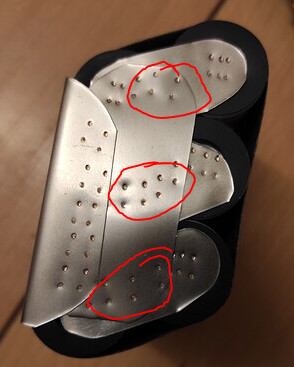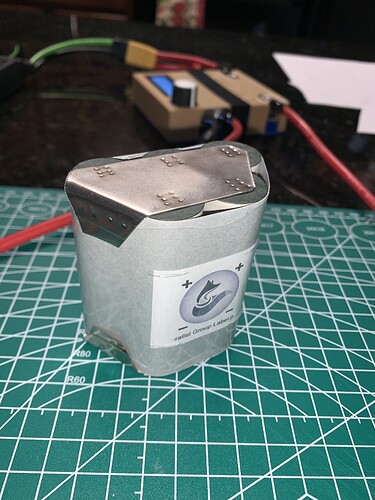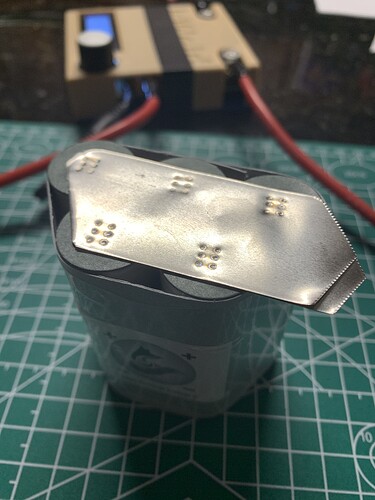Is it recommended/OK to sand/file down the malectrics probes? I find it really hard to spot weld precisely on the positive of 18650s
Yes. They should be pretty sharp
Good question. Here is an example of what people are wanting to buy: link here
However there is also a lot of demand for 4s1p & 6s1p using the MOLICEL 21700 P42A 4200MAH 45A cells. I personally would like to experiment using 6s1p packs in two different capacities:
- MOLICEL P28A 18650 2800MAH 35A cells
- MOLICEL 21700 P42A 4200MAH 45A cells
The low amount of cells per pack is gonna drive the cost up $/kwh but if u wanted me to build one I don’t see why we couldn’t
Awesome, thanks man. I’ll send you a PM.
Great. Examples of my work can be found in this thread
-
First, and most important:
If at all possible, do your soldering (or at least your tinning) before you weld the nickel to the cells. That way you can get it as hot as you need without worrying about the cells. -
If you must solder onto nickel that’s already welded, do it between cells, or as far from the cells as possible to avoid excess heat transfer. You can also use a piece of aluminum or copper as a heat sink to soak up excess heat before it reaches a cells.
-
use a powerful iron on the hottest setting. More heat for less time is better than less heat for longer.
-
Get the nickel hot. You will probably need to have your iron set hotter than you do for regular wires.
-
Tin the nickel before trying to add a wire. Make a puddle of solder (and flux) on the nickel, and hold your iron on it, maybe scratching around a bit, until you see the solder wet out against the nickel instead of beading up.
-
If you have it, use a more aggressive (acid) type of flux. Clean this off thoroughly afterwards, because it can cause corrosion if left.
Yep did that all that and came out real nice
What is the best way to test them?
I pulled hard and they didn’t come off so I assume they are ok?
Also if anyone can confirm these all look good
On some test cells the welds did come off with a lot of force but left bits of nickel behind
Yeah, that’s the best nondestructive (or selectively destructive? only destroys the bad ones) test.
Yep perfect
Looks like everything is good then
Will hopefully finish the entire thing on sudnah
I’ve found this to be difficult to do and instead applied Flux to scuffed up nickel, clamped a wire against the nickel where I want to solder (gently), then heat up the wire and glob on solder. Is this a bad way of doing it? I havent had any issues, but I don’t imagine the nickel heats up quite as much than if I were to tin the nickel first, then heat up the puddle again and drop the wire in
Welds without the cell below them, like this, is something I would never do. Especially on the positive side.

Yeah thinking about it blowing through sounds like a bad time
I pre-tin just about everything I intend to attach a wire to.
My method for nickel is to add a drop of flux, put some solder on the iron, plonk the iron down in the flux, and wait for the magic to happen. It usually takes less than a second.
With that method, you don’t have to worry about overheating the wire insulation (for non-silicone wire), or having solder wick up the wire due to excess heat and time.
Then once you’ve got a tinned spot on the nickel and a tinned wire (I said I tin everything, right?) just press the wire against the puddle with the iron and boom, the two will become one.
It took me way too long to understand how important pre-tinning and flux are. Great explanation.
I suppose I just haven’t been using enough heat; it takes a while - like a good 5-10 seconds last time I did it the way you explained.
I’ll just crank up the temp next time
Bear in mind, you need both heat, and intimate contact, between all three parts: The solder, the flux, and the substrate (nickel in this case).
If you don’t have all three hot at the same time, and touching each other at the same time, it won’t work.
Also a more aggressive (acid type) flux can really help with nickel, since it’s a fairly inert and unreactive metal.
Scratching up the nickel before soldering is make or break in my experience






